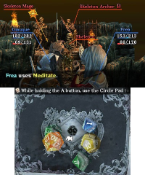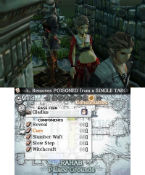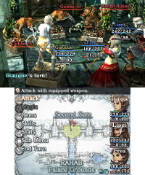I got a total of 19. I was able to roll for everything except for LARPing, but I had a critical failure on the d20.
Crimson Shroud Review
|
|
See PixlBit's Review Policies

On 02/16/2013 at 12:20 PM by Angelo Grant You must roll an 18 or higher to enjoy this game. Roll 1 D20. Add an additional D10 if you enjoy RPGs in general. Additionally, add 1 D8 if you enjoy JRPGs, 1 D6 if you like tabletop RPGs, 1 D6 for western RPGs, and 1 D4 for MMORPGs. Finally, add +2 to your total if you’ve ever been LARPing. |

Recommended for those who don’t mind shorter RPGs, lengthy encounters, and want to experience a unique combination of tabletop and JRPG mechanics.
Have you ever played a tabletop RPG? If not, the formula in my abstract may sound like some sort of foreign language to you. Essentially, a tabletop RPG is a lot like a video game RPG but instead of a computer calculating random numbers, dice rolls determine all your actions. Will your attack hit? Roll some dice according to a formula. How much damage will it do? Roll another set of dice. Will the attack be critical? Roll again. You get the idea. You honestly can’t even eat a snack without rolling for initiative. It’s this problem that gave rise to the digital version of the RPG, which replaces dice rolls with random numbers generated by a computer.

Obviously the tabletop version of the RPG games predates our digital equivalents by quite some time, but oddly enough, I can’t recall the two ever coming together to form a hybrid quite like Crimson Shroud. It’s an experimental take that practically reverses the trend most would associate with games like Baldur's Gate. It’s almost as if its creators took the thought process backwards, imagining what would happen if the digital RPG came first, and dice rolling was added, instead of taken away, to create the illusion of playing a board game. The results of this experiment are, in a word, debatable.
My main reason for calling this game an experiment is its length. Crimson Shroud is short. Very short. A single playthrough of the game will take around 10 hours, and an experienced player can likely take it down in 5. The game does have some built in replay value however, as it is designed to be played through twice. You will keep a fair amount of your loot for the second run, but the game will be more difficult and tactically demanding. Additionally, you’ll have some new dialogue and additional areas to explore that were previously unavailable.

So how do the hybrid game styles come together? Well, it starts with map exploration. In Crimson Shroud, I never feel like I was playing as a protagonist. Instead, I felt like I was role-playing a person playing an RPG under the watch of a dungeon master. This was reflected mechanically by the method by which I moved my party, which was done by selecting their destination by moving a marker on a map instead of walking from one position to another.
The story telling method also helped with this illusion. Long text scrolls explain the story in the sort of richly detailed language you’d expect from someone who put endless thought into creating their world, and wants to impart as much of their vision as possible. Needless to say, if a lot of reading in a video game bothers you as it did some who played Lost Odyssey, this may not be for you.

Occasionally, after selecting a location to move to, an event will take place requiring a dice roll to determine the outcome. For example, if you have the option to sneak past a group of monsters instead of fighting them, you’ll have to roll to determine if you’ll be successful. There’s no trickery here from what I can tell; you’re actually rolling a set of true virtual dice, and the system actually has fairly realistic physics that respond the same way you’d expect real dice to. It’s a neat feature that made me feel like I took a greater role in the system’s determinations.
Where dice rolls really get involved is in the combat. At face value, it’s a standard turn based JRPG. Each turn allows a character to perform a skill, and to either cast a spell or attack. The dice rolls add flavor to this by determining bonuses, or in some cases, chances to hit. I enjoyed this quite a bit at first, but after a while, I began to wish for a way to speed things along, especially in the second half of the game when encounters became fairly lengthy. Fortunately, unlike its tabletop cousin, you don’t roll dice for everything, but you will roll them a couple of times per round, especially if you choose to add bonus dice to a command from your stash.
Now, about that stash of dice. As per usual, spells and skills are often assigned an element, which is either strong or weak against other elements. Elemental skills and spells can also be chained together to earn bonus dice. In short, each elemental ability adds another icon to a chain on the bottom of the screen, so long as the element in front of it is not weak to the element that’s being cast, or the element was not already used earlier in the chain.
From the third link upward, each additional element chained earns you a bonus die, which has more sides depending on how far it is up the chain. For example, link 3 will earn you a D4, link 4 will earn you a D6, and so on. These can be multiplied by using a spell called “Dice Lure” which adds +2 to dice sides per level, so Dice Lure would turn link 3 to a D6, and Dice Lure 2 would change it to a D8. These dice can then be rolled to add points to damage or chance-to-hit on attacks or spells.
After resolving an encounter, you get to pick your loot. Here again your stash of dice takes on another role (see what I did there?) and, depending on how well you perform in battle, you’ll be given a number of points to spend on selecting your spoils, but you may not have enough to grab everything you want. If that’s the case, you can cash in your earned dice to add points to your total, with the amount of points being determined by how many sides a die has. Since you have a limited number of slots to hold these bonus dice, you can’t hoard them up then spend them on a super expensive item, you’ll have to build up your chain, and spend your smaller dice in battle to keep room available for your larger dice. This is all very important since Crimson Shroud has no levels and your characters only grow stronger based on the equipment they use.
The artistic styling, story, and music all convey the spirit of its creator Yasumi Matsuno. Anyone who has played any of his past works will find themselves in very familiar territory. The soundtrack is instantly reminiscent of Final Fantasy Tactics, while the story speaks of hidden political agendas and secret religious histories with a distinctly eastern European flair.
Don’t expect much in the way of animation however. This game is designed to give you the feeling of playing with the painted miniatures commonly used in tabletop games. While there may be changes in character placement or camera angle, that’s as dynamic as it gets, so don’t come here expecting Final Fantasy style visuals for attacks and spells. The same goes for the use of 3D. It gives a great diorama viewpoint on the playing field, but since nothing really moves very much, I only occasionally moved the slider up to take a peek at how things looked, then turned it off again.
This game also has one very irritating problem. At one point, you’ll have to rely on an item an enemy may drop in order to advance. First of all, the game doesn’t give you any hints as to how to advance, so you have to almost randomly stumble upon the solution, or look it up online. Second, you have to handle the encounter in a specific way to get the enemy you need to kill to spawn. Finally, it’s still not guaranteed that the enemy will even drop the item. I ended up stuck at this point for 5 hours before I resorted to looking up the solution online, and even then I still had trouble getting the item to actually drop. It’s a shame, because aside from this flaw, the game is very solid.
Recommending a title like Crimson Shroud isn’t easy. While I personally enjoyed the novelty of rolling dice, it absolutely causes the encounters to become lengthy, and when grinding without benefit is required on top of that, it can make the experience a drag. Since the majority of the game is spent in combat, that’s a pretty defining factor, and you may not even know if it’s something you can tolerate until you try it out yourself. Its $7.99 price point puts it in an odd spot as well, since you may feel ripped off if you don’t enjoy the game. The best I can do as a reviewer is let you make the call based on what I’ve told you, and hopefully you can make a thoughtful decision based on this information that’s better than a random roll of the dice (Ha! Did it again!).











Comments